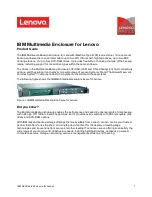
54
Configuring a Storage Array
NOTE:
All parameters are optional. You can use one or all of the parameters as
needed to define your configuration.
When you use the
autoConfigure storageArray
command without specifying
the number of disk groups, the firmware determines how many virtual disks
and disk groups to create. The firmware creates one disk group and one virtual
disk up to the maximum number that the storage array can support. When
you specify the number of disk groups, the firmware creates only that number
of disk groups. When you create more than one disk group, all of the disk
groups have the same number of physical disks and the same number of
virtual disks.
•
The
diskGroupWidth
para
meter defines the number of unassigned
physical disks wanted for each new disk group.
•
The
diskGroupCount
parameter defines the number of new disk groups
wanted in the storage array.
•
The
virtualDisksPerGroupCount
para
meter defines the number of
virtual disks wanted in each disk group.
•
The
hotSpareCount
para
meter defines the number of hot spares wanted
in each disk group.
•
The
segmentSize
para
meter defines the amount of data in kilobytes that
the RAID controller module writes on a single physical disk in a virtual disk
before writing data on the next physical disk. The smallest units of storage
are data blocks. Each data block stores 512 bytes of data. The size of a
segment determines how many data blocks that it contains. An 8-KB
segment holds 16 data blocks. A 64-KB segment holds 128 data blocks.
Valid values for the segment size are 8, 16, 32, 64, 128, 256, and 512.
When you enter a value for the segment size, the value is checked against
the supported values provided by the RAID controller module at run time.
If the value you enter is not valid, the RAID controller module returns a
list of valid values.
If the virtual disk is for a single user with large I/O requests (such as
multimedia), performance is maximized when a single I/O request can be
serviced with a single data stripe. A data stripe is the segment size multiplied
by the number of physical disks in the disk group that are used for data
storage. In this environment, multiple physical disks are used for the same
request, but each physical disk is accessed only once.
Summary of Contents for PowerVault MD3000i
Page 12: ...12 Contents ...
Page 42: ...42 About the Script Commands ...
Page 90: ...90 Using the Virtual Disk Copy Feature ...
Page 104: ...104 Maintaining a Storage Array ...
Page 222: ...222 Script Commands ...
Page 228: ...228 Sample Script Files ...
Page 236: ...236 Index ...
















































